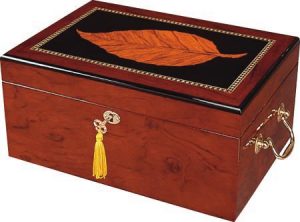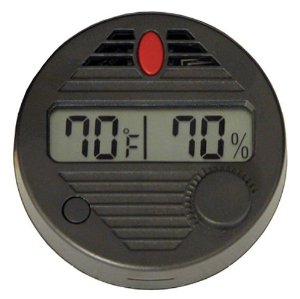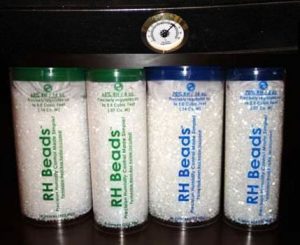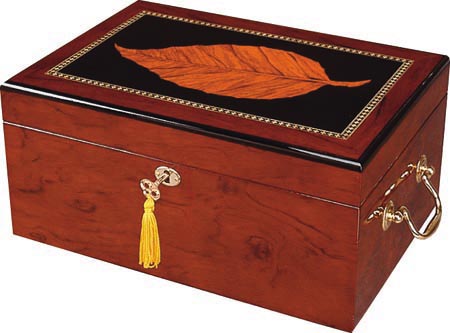When I first got into the hobby, I documented the process I used for acquiring and seasoning my first humidor. I’d like to share this to help those that are looking to get into the hobby or are at the beginning stages.
About three months after having my first cigar, I had the urge to start looking into what it would take to have a small collection of cigars on hand so that I could smoke one on occasion. I am a researcher, so anything I do a spend a good amount of time trying to learn about it so that I make sure I am getting what I need and the best option for those items as well. I start my journey by looking into humidors and what is needed to set one up.
There are many websites that sell humidors, but I won’t really go into them as you’ll have to determine where the best place to purchase yours from is. I checked the various websites and tried to find as many reviews for the various ones that caught my attention. I also read up on humidors on some cigar forums to get some opinions as well as learn about what it takes to set one up which was much more in depth from what I had expected. I even went to a local cigar shop to see some humidors in person. One of the tips I found the most helpful was to look for quality construction. Cheaply priced humidors are typically just that, cheap. They won’t be made with good materials or sometimes even the proper materials. Another tip is that the humidity measuring devices (hygrometer) and the humidification devices that are included with the humidors are typically not of the best quality and don’t work very well, so it is best to buy add-on pieces to provide these functions. The best tip I found, which I didn’t find out how true it was until after I had already purchased my humidor, was to buy one that is quite a bit larger than what you think you will need. If you think you’re more on the obsessive side of things and tend to go in full force, you’ll end up needing a larger humidor sooner rather than later. It’s almost a right of passage for cigar smokers to incrementally grow their collection and in turn trade up in humidor space.

I purchased a Deauville 150 count humidor. Based on my research, this humidor was a good product at a good price. Other sites may have the items cheaper, but once you include tax (if it applies to the site you are purchasing from) and shipping, it can have a large effect on total price. Next, I purchased a HygroSet II hygrometer and Boveda calibration kit from Amazon. My final purchase for the humidor setup was a tube of RH humidification beads from cigarmony.com. I will explain how I went through the setup of everything below.
A new humidor requires seasoning and once seasoned needs to have its humidity maintained in some fashion. The inside of a humidor should be lined in dried Spanish cedar wood. The thicker the lining the better as it will provide the best environment for the cigars. When you receive your new humidor, the internal wood will not contain much moisture. The inside needs to be seasoned which consists of allowing it to absorb moisture so that it can maintain the desired humidity level. I found many methods of seasoning based on my research. The method you choose is really up to you, but what I did was fill up a shot glass with distilled water, place it into the humidor, close it up and let it sit for two weeks. I would check on it every couple of days and could see the water level in the shot glass slowly go down as the wood absorbed the moisture. Any method you use that consists of using water, you should use distilled water so that you are using something with the least amount of impurities. There are also seasoning packs that you can use from companies like Boveda if you choose to go that route instead of using water.
Once I seasoned the humidor, I needed to get the internal humidity of the humidor to the level I wanted. The easy rule of thumb that is thrown around is that the inside of the humidor should be at 70 degrees Fahrenheit and 70% humidity. The humidity level is where I feel the rule is a bit too simple. People seem to like different humidity levels as they feel the cigars react differently. Some feel that 70% is too humid and that the cigar doesn’t smoke and burn well at that level, so they prefer a lower humidity level. From what I read, people stay within the 60% to 70% range. I decided that I would go with 65% as the level that I would aim for.

The HygroSet II is a digital hygrometer which measures humidity and temperature. One of the other great features is that the unit is adjustable so that it can be calibrated. The Boveda calibration kit consists of a large Ziploc bag and a 75% humidity pack. To calibrate the hygrometer, you open up the Ziploc bag, insert the hygrometer and let it sit for their recommended timeframe. The hygrometer should then read 75%. If it doesn’t, you can make the necessary adjustment on the HygroSet II to have it read 75%. There is also a calibration test called the salt test where you simply fill a bottle cap with salt and add a few drops of water. Let it sit in this bag for 24 hours and the reading should equal 75%
Now that I had the tool to be able to read the humidity level, I needed to setup the way that I would maintain the humidity inside of the humidor. I chose to go with
humidification beads. There are many options available for this such as humidity packs, gels and even kitty litter. When you go with beads, you can select the humidity level you want and they are formulated to be able to maintain that percentage. These beads are very small and are designed to go into a mesh bag that came with the beads. What needs to be done is that you wet a percentage of the beads with distilled water and then add them to the bag with the rest of the beads and then put the bag in the humidor. The beads are designed to release and absorb moisture in order to keep the humidity at the percentage they were designed for. You need to monitor the humidity inside the humidor and once it starts getting below your target, you’ll need to recharge the beads by adding distilled water to the proper percentage of the beads again. The beads should be able to last a very long time which is one of the advantages of the beads over the other humidification methods. The other thing to know about using beads is that the amount of beads that are needed are calculated based on the amount of internal volume of your humidor. Whichever bead provider you go with will have a calculator so that you can determine what the internal volume of your humidor is and how much of the beads are necessary for you.

Once I had the hygrometer and beads ready, I put them in the humidor and removed the shot glass. I kept the humidor closed for a couple of days before checking on it. When I opened it up, my humidity level was around 80%, way above what I wanted. The amount of time I had the shot glass in there allowed the wood to absorb a large amount of moisture. The easiest way for me to reduce the moisture inside was just to leave the humidor open for a little bit to let it dry out. I left it open for two hours and then closed it and let it sit for another day. After checking back in, it was still too humid, so after a few more sessions of opening the lid, I was able to get to the desired level.
It takes a bit of patience to go through this process as you shouldn’t have any cigars in the humidor while it’s happening. Once you add cigars, you’ll want to keep an eye on the humidity levels as it may change depending on what moisture level is in the cigars you add. They can raise or lower the internal humidity level and you want to make sure that your humidification choice is able to adjust appropriately.
I hope I’ve outlined a process that can be easily duplicated if you choose to go this route. If you have any questions about this process, feel free to leave a comment here with your question and we will do our best to help.




